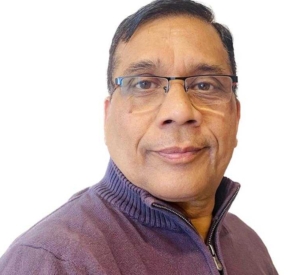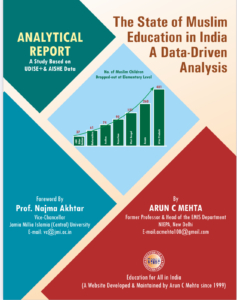Gender Parity Index Higher Education in India (AISHE 2021-22) [PDF]
Bridging the Gender Gap: Analyzing India’s Progress in Gender Parity Index (GPI) in Higher Education based on AISHE 2021-22
Introduction
Gender parity in education is a fundamental human right and a catalyst for socio-economic development and empowerment. The Gender Parity Index (GPI) is a critical measure of progress towards achieving gender equality in educational attainment. In India, pursuing gender parity in higher education has been a long-standing priority, with the government implementing various policies and initiatives to address this challenge. This article discusses the state of GPI in higher education in India, analyzing the trends and disparities across states and social groups and exploring the measures undertaken to close the remaining gaps.
Gender Parity Index (GPI): Computation & Interpretation
The Gender Parity Index (GPI) is a socio-economic indicator that measures the relative access to education of males and females. It is calculated by dividing the value corresponding to females by the value corresponding to males for a given indicator. In the context of higher education, the GPI is calculated using the following formula:
- GPI = Gross Enrolment Ratio (GER) for females / Gross Enrolment Ratio (GER) for males
- Where:
- Gross Enrolment Ratio (GER) for females = Total female enrollment in higher education / Female population of the official age group
- Gross Enrolment Ratio (GER) for males = Total male enrollment in higher education / Male population of the official age group
The GPI value can be interpreted as follows:
- GPI = 1: indicates parity between males and females in higher education enrollment.
- GPI > 1 indicates a higher proportion of females enrolled in higher education than males.
- GPI < 1 indicates a lower proportion of females enrolled in higher education than males.
For example, if the GER for females is 30% and the GER for males is 25%, then:
GPI = 30% / 25% = 1.2; this indicates that the enrollment of females in higher education is 1.2 times higher than that of males, suggesting a favorable situation for females regarding access to higher education.
The GPI is often calculated at different levels, such as national, state, district, or even institutional levels, to assess the gender balance in higher education enrollment within specific geographic or administrative units.
It is important to note that while the GPI provides a valuable snapshot of gender parity, it should be interpreted in conjunction with other indicators and contextual factors to gain a comprehensive understanding of gender disparities in education.
The Data Set
The present article is based on the All India Survey on Higher Education (AISHE) 2021-22, a comprehensive database managed by the Department of Higher Education, Ministry of Education, Government of India. AISHE, initiated in 2011, is an annual web-based, pan-India survey that collects data on various aspects of higher education, including student enrollment, faculty, infrastructure, and finance. The survey aims to create a robust database to facilitate informed policy-making and effective monitoring of the country’s higher education sector.
Gender Parity Index (GPI) at Higher Education Level in India: 2017-18 to 2021-22
|
All/SC/ST Students |
Year | ||||
| 2017-18 | 2018-19 | 2019-20 | 2020-21 | 2021-22 | |
| All Students | 1.01 | 1.05 | 1.06 | 1.05 | 1.01 |
| Scheduled Castes | 1.00 | 1.06 | 1.08 | 1.07 | 1.01 |
| Scheduled Tribes | 0.91 | 0.96 | 1.00 | 1.02 | 0.98 |
Source: AISHE 2021-22 (download)
GPI in Higher Education: All India Perspective
At the all-India level, the GPI in higher education has exhibited a positive trajectory, reaching 1.01 in 2021-22, indicating near-parity between males and females. It always remained above one from 2017-18 to 2021-22, which is also true for the Scheduled Castes population. However, this national figure masks the variations across states and social groups. Several states, such as Kerala (1.44), Meghalaya (1.24), and Himachal Pradesh (1.33), have consistently maintained a GPI above 1, reflecting a higher enrollment of females in higher education compared to males.
On the other hand, states like Bihar (0.92), Rajasthan (0.97), Gujarat & Maharashtra (0.90), Odisha ().88), and Madhya Pradesh (0.94) continue to grapple with gender disparities, with a GPI below 1, indicating lower enrollment of females in higher education relative to males.
GPI in Higher Education: Scheduled Caste (SC) and Scheduled Tribe (ST) Perspective
The analysis of GPI for Scheduled Caste (SC) and Scheduled Tribe (ST) populations reveals a more nuanced picture. The GPI for the ST population in 2021-22 at the national level stood at 0.98, indicating near-parity but still lagging slightly behind the overall GPI. However, several states, such as Chhattisgarh (1.33), Himachal Pradesh (1.36), Kerala (1.80) and Haryana (1.12), have made significant strides in achieving gender parity for the SC population in higher education.
The situation is more concerning for the ST population, with the national GPI standing at 0.79 in 2021-22, suggesting a substantial gender gap in higher education enrollment. States like Meghalaya (1.31) and Nagaland (1.25) have performed well in terms of GPI for the ST population, while states like Uttar Pradesh (0.90) and Rajasthan (0.96) continue to face challenges in achieving gender parity for this marginalized group.
The Unfinished Task and Policy Implications: While progress has been made, the analysis highlights that achieving gender parity in higher education remains unfinished, particularly for marginalized communities like the SCs and STs. Addressing the challenge requires a multi-faceted approach that tackles cultural biases, socio-economic barriers, and infrastructural deficiencies.
Improving the efficiency of the school education sector is very crucial to laying a solid foundation for higher education aspirations and preparedness. Initiatives such as the Samagra Shiksha Abhiyan, which aims to enhance access, equity, and quality of school education, can play a pivotal role.
Furthermore, the government has implemented targeted schemes like the Post-Matric Scholarship for SC and ST students, which provide financial assistance and support services to encourage enrollment and retention in higher education.
Initiatives like the Unnat Bharat Abhiyan, which connects higher education institutions with local communities, may play a pivotal role in creating awareness and fostering an enabling environment for girls and women from marginalized communities to pursue higher education.
Conclusion and the Way Forward
The analysis of GPI in higher education in India reveals a mixed picture – while progress has been made at the national level, significant disparities persist across states and social groups. Achieving the National Education Policy (NEP) 2020 target of a 50% increase in higher education enrollment by 2035 will remain an elusive goal unless concerted efforts are made to address the persistent gender gaps, particularly for marginalized communities like the SCs and STs.
The way forward lies in a comprehensive and inclusive approach that combines targeted financial support, infrastructural development, community engagement, and a holistic transformation of societal attitudes and norms. Collaboration between government agencies, educational institutions, civil society organizations, and community leaders is vital to creating an enabling environment that empowers girls and women from all backgrounds to pursue higher education and realize their full potential.
Only through sustained efforts and an unwavering commitment to gender equality can India truly harness the transformative power of education and pave the way for a more just, equitable, and prosperous society.
|
S.No. |
State/UTs |
Scheduled Castes |
||||
| 2017-18 | 2018-19 | 2019-20 | 2020-21 | 2021-22 | ||
| India | 1.00 | 1.06 | 1.08 | 1.07 | 1.01 | |
|
1 |
A & N Islands |
|||||
| 2 | Andhra Pradesh | 0.89 | 0.91 | 0.93 | 0.98 | 0.97 |
| 3 | Arunachal Pradesh | |||||
| 4 | Assam | 1.04 | 1.06 | 1.08 | 1.11 | 1.07 |
| 5 | Bihar | 0.66 | 0.63 | 0.64 | 0.72 | 0.72 |
| 6 | Chandigarh | 0.96 | 1.02 | 1.03 | 0.95 | 0.99 |
| 7 | Chhattisgarh | 0.95 | 1.07 | 1.11 | 1.11 | 1.14 |
| 8 | Delhi | 0.92 | 1.04 | 1.05 | 0.91 | 0.97 |
| 9 | Goa | 0.91 | 0.94 | 0.98 | 0.76 | 0.74 |
| 10 | Gujarat | 0.87 | 0.90 | 0.92 | 0.89 | 0.92 |
| 11 | Haryana | 1.08 | 1.20 | 1.23 | 1.16 | 1.21 |
| 12 | Himachal Pradesh | 1.25 | 1.35 | 1.39 | 1.35 | 1.36 |
| 13 | Jammu and Kashmir | 1.28 | 1.33 | 1.41 | 1.27 | 1.21 |
| 14 | Jharkhand | 0.88 | 0.93 | 0.93 | 0.94 | 0.87 |
| 15 | Karnataka | 1.00 | 1.02 | 1.02 | 1.02 | 0.93 |
| 16 | Kerala | 1.88 | 1.93 | 1.94 | 1.91 | 1.80 |
| 17 | Ladakh | 14.84 | ||||
| 18 | Lakshadweep | |||||
| 19 | Madhya Pradesh | 0.90 | 0.97 | 1.01 | 1.01 | 0.98 |
| 20 | Maharashtra | 0.93 | 0.97 | 1.02 | 0.96 | 0.93 |
| 21 | Manipur | 0.92 | 0.95 | 1.02 | 0.87 | 1.01 |
| 22 | Meghalaya | 0.77 | 2.71 | 0.86 | 0.94 | 1.17 |
| 23 | Mizoram | 0.85 | 0.99 | 0.70 | 1.03 | 1.48 |
| 24 | Nagaland | |||||
| 25 | Odisha | 0.74 | 0.78 | 0.82 | 0.86 | 0.79 |
| 26 | Puducherry | 0.89 | 0.93 | 0.95 | 1.00 | 1.01 |
| 27 | Punjab | 1.23 | 1.42 | 1.42 | 1.48 | 1.41 |
| 28 | Rajasthan | 0.91 | 0.96 | 1.01 | 0.99 | 0.96 |
| 29 | Sikkim | 0.76 | 0.84 | 0.90 | 0.89 | 0.84 |
| 30 | Tamil Nadu | 1.07 | 1.06 | 1.09 | 1.12 | 1.05 |
| 31 | Telangana | 1.13 | 1.26 | 1.31 | 1.24 | 1.21 |
|
32 |
D & N Haveli and Daman & Diu |
1.37 |
1.41 |
1.43 |
1.35 |
1.28 |
| 33 | Tripura | 0.84 | 0.85 | 0.79 | 0.94 | 0.89 |
| 34 | Uttar Pradesh | 1.09 | 1.24 | 1.24 | 1.18 | 1.08 |
| 35 | Uttarakhand | 1.04 | 1.08 | 1.14 | 1.25 | 1.22 |
| 36 | West Bengal | 0.92 | 0.98 | 1.03 | 1.05 | 0.96 |
- What is the Gender Parity Index (GPI)? The Gender Parity Index (GPI) is a socio-economic indicator that measures the relative access to education between males and females. GPI is calculated by dividing the Gross Enrolment Ratio (GER) for females by the GER for males.
- How is the GPI in higher education calculated? The GPI in higher education is calculated by dividing the Gross Enrolment Ratio (GER) for females in higher education by the GER for males in higher education. GER is the total enrollment in higher education, irrespective of age, expressed as a percentage of the eligible official population in the appropriate age group.
- What does a GPI value of 1 indicate? A GPI value of ONE indicates parity between males and females in higher education enrollment, meaning that the enrollment rates are equal for both genders.
- What do GPI values greater than ONE and less than ONE signify? A GPI value greater than 1 indicates a higher proportion of females enrolled in higher education compared to males, while a GPI value less than 1 indicates a lower proportion of females enrolled in higher education compared to males.
- What are the key findings from the AISHE data regarding GPI in Indian higher education? The analysis of AISHE data reveals that while progress has been made at the national level, with the overall GPI reaching 1.01 in 2021-22, significant disparities persist across states and social groups, particularly for marginalized communities like Scheduled Castes and Scheduled Tribes.
- What policy implications emerge from the analysis of GPI in Indian higher education? Addressing the unfinished task of achieving gender parity in higher education requires a multi-faceted approach that tackles socio-economic barriers, cultural biases, and infrastructural deficiencies. Initiatives like financial assistance, community engagement, and a holistic transformation of societal attitudes and norms are crucial.
|
S.No. |
State/UTs |
Scheduled Tribes |
||||
| 2017-18 | 2018-19 | 2019-20 | 2020-21 | 2021-22 | ||
| India | 0.91 | 0.96 | 1.00 | 1.02 | 0.98 | |
|
1 |
A & N Islands |
1.34 |
1.66 |
1.96 |
1.55 |
1.55 |
| 2 | Andhra Pradesh | 0.83 | 0.82 | 0.82 | 0.87 | 0.88 |
| 3 | Arunachal Pradesh | 0.87 | 1.06 | 0.95 | 0.97 | 0.90 |
| 4 | Assam | 0.97 | 1.01 | 1.10 | 1.08 | 1.04 |
| 5 | Bihar | 0.71 | 0.73 | 0.82 | 0.79 | 0.82 |
| 6 | Chandigarh | |||||
| 7 | Chhattisgarh | 1.08 | 1.22 | 1.31 | 1.35 | 1.42 |
| 8 | Delhi | |||||
| 9 | Goa | 1.18 | 1.30 | 1.42 | 1.32 | 1.33 |
| 10 | Gujarat | 1.03 | 1.03 | 1.06 | 1.01 | 1.06 |
| 11 | Haryana | |||||
| 12 | Himachal Pradesh | 1.15 | 1.27 | 1.29 | 1.25 | 1.31 |
| 13 | Jammu and Kashmir | 1.02 | 1.01 | 0.92 | 0.92 | 0.89 |
| 14 | Jharkhand | 1.13 | 1.12 | 1.17 | 1.14 | 1.12 |
| 15 | Karnataka | 1.00 | 1.03 | 1.03 | 1.02 | 0.95 |
| 16 | Kerala | 1.50 | 1.49 | 1.56 | 1.52 | 1.41 |
| 17 | Ladakh | 1.91 | 2.01 | 1.68 | ||
| 18 | Lakshadweep | 3.20 | 3.81 | 3.65 | 3.68 | 5.00 |
| 19 | Madhya Pradesh | 0.86 | 0.94 | 0.96 | 1.05 | 0.97 |
| 20 | Maharashtra | 0.71 | 0.76 | 0.78 | 0.78 | 0.78 |
| 21 | Manipur | 0.97 | 1.02 | 1.11 | 1.08 | 1.10 |
| 22 | Meghalaya | 1.17 | 1.27 | 1.33 | 1.36 | 1.31 |
| 23 | Mizoram | 0.88 | 0.97 | 0.99 | 1.05 | 1.05 |
| 24 | Nagaland | 1.12 | 1.20 | 1.27 | 1.24 | 1.25 |
| 25 | Odisha | 0.77 | 0.80 | 0.87 | 0.90 | 0.86 |
| 26 | Puducherry | |||||
| 27 | Punjab | |||||
| 28 | Rajasthan | 0.89 | 0.95 | 1.02 | 1.04 | 0.96 |
| 29 | Sikkim | 1.37 | 1.58 | 1.56 | 1.45 | 1.42 |
| 30 | Tamil Nadu | 0.82 | 0.79 | 0.91 | 0.89 | 0.75 |
| 31 | Telangana | 0.88 | 0.94 | 0.99 | 0.97 | 0.94 |
|
32 |
D & N Haveli and Daman & Diu |
1.01 |
1.07 |
1.27 |
1.20 |
1.17 |
| 33 | Tripura | 0.75 | 0.81 | 0.72 | 0.89 | 0.84 |
| 34 | Uttar Pradesh | 0.89 | 1.00 | 1.06 | 1.11 | 0.90 |
| 35 | Uttarakhand | 1.04 | 1.06 | 1.05 | 1.11 | 1.00 |
| 36 | West Bengal | 0.89 | 0.97 | 1.02 | 1.03 | 1.05 |




